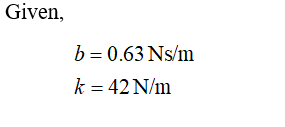A 0.830-kg block oscillates on the end of a spring whose spring constant is k = 42.0 N/m . The Part B mass moves in a fluid which offers a resistive force F = -bv, where b = 0.630 N · s/m. What is the fractional decrease in amplitude per cycle? ΑΣφ ? ΔΑ %3D A Submit Request Answer
A 0.830-kg block oscillates on the end of a spring whose spring constant is k = 42.0 N/m . The Part B mass moves in a fluid which offers a resistive force F = -bv, where b = 0.630 N · s/m. What is the fractional decrease in amplitude per cycle? ΑΣφ ? ΔΑ %3D A Submit Request Answer
Principles of Physics: A Calculus-Based Text
5th Edition
ISBN:9781133104261
Author:Raymond A. Serway, John W. Jewett
Publisher:Raymond A. Serway, John W. Jewett
Chapter12: Oscillatory Motion
Section: Chapter Questions
Problem 66P: Consider the damped oscillator illustrated in Figure 12.16a. The mass of the object is 375 g, the...
Related questions
Question
Need help with part Band C pls. For part A, i found that the period is T= 0.88327 s
![Constants I Perioc
A 0.830-kg block oscillates on the end of a spring
whose spring constant is k = 42.0 N/m . The
Part B
mass moves in a fluid which offers a resistive force
F = -bv, where b = 0.630 N · s/m.
What is the fractional decrease in amplitude per cycle?
ν ΑΣφ
?
ΔΑ
A
Submit
Request Answer
Part C
Write the displacement x as a function of time t in seconds if at t = 0, x = 0, and at t = 1.00s, x = 0.120m.
x = (0.240m) sin[(7.10rad/s)t]
x = (0.240m)e-(0.380s")t sin[(7.10rad/s)t]
x = (0.240m)e(0.3805-)t cos[(7.10rad/s)t]
O x = (0.240m) cos[(7.10rad/s)t]
Submit
Request Answer](/v2/_next/image?url=https%3A%2F%2Fcontent.bartleby.com%2Fqna-images%2Fquestion%2F5a38ead4-301e-4939-b612-53a128a0d9eb%2Fffa057e7-2956-4282-8a8d-9398e96ce329%2Fm6575ec_processed.png&w=3840&q=75)
Transcribed Image Text:Constants I Perioc
A 0.830-kg block oscillates on the end of a spring
whose spring constant is k = 42.0 N/m . The
Part B
mass moves in a fluid which offers a resistive force
F = -bv, where b = 0.630 N · s/m.
What is the fractional decrease in amplitude per cycle?
ν ΑΣφ
?
ΔΑ
A
Submit
Request Answer
Part C
Write the displacement x as a function of time t in seconds if at t = 0, x = 0, and at t = 1.00s, x = 0.120m.
x = (0.240m) sin[(7.10rad/s)t]
x = (0.240m)e-(0.380s")t sin[(7.10rad/s)t]
x = (0.240m)e(0.3805-)t cos[(7.10rad/s)t]
O x = (0.240m) cos[(7.10rad/s)t]
Submit
Request Answer
Expert Solution
Step 1

Trending now
This is a popular solution!
Step by step
Solved in 3 steps with 3 images

Knowledge Booster
Learn more about
Need a deep-dive on the concept behind this application? Look no further. Learn more about this topic, physics and related others by exploring similar questions and additional content below.Recommended textbooks for you

Principles of Physics: A Calculus-Based Text
Physics
ISBN:
9781133104261
Author:
Raymond A. Serway, John W. Jewett
Publisher:
Cengage Learning

Physics for Scientists and Engineers, Technology …
Physics
ISBN:
9781305116399
Author:
Raymond A. Serway, John W. Jewett
Publisher:
Cengage Learning

University Physics Volume 1
Physics
ISBN:
9781938168277
Author:
William Moebs, Samuel J. Ling, Jeff Sanny
Publisher:
OpenStax - Rice University

Principles of Physics: A Calculus-Based Text
Physics
ISBN:
9781133104261
Author:
Raymond A. Serway, John W. Jewett
Publisher:
Cengage Learning

Physics for Scientists and Engineers, Technology …
Physics
ISBN:
9781305116399
Author:
Raymond A. Serway, John W. Jewett
Publisher:
Cengage Learning

University Physics Volume 1
Physics
ISBN:
9781938168277
Author:
William Moebs, Samuel J. Ling, Jeff Sanny
Publisher:
OpenStax - Rice University

College Physics
Physics
ISBN:
9781285737027
Author:
Raymond A. Serway, Chris Vuille
Publisher:
Cengage Learning

Classical Dynamics of Particles and Systems
Physics
ISBN:
9780534408961
Author:
Stephen T. Thornton, Jerry B. Marion
Publisher:
Cengage Learning

Physics for Scientists and Engineers: Foundations…
Physics
ISBN:
9781133939146
Author:
Katz, Debora M.
Publisher:
Cengage Learning